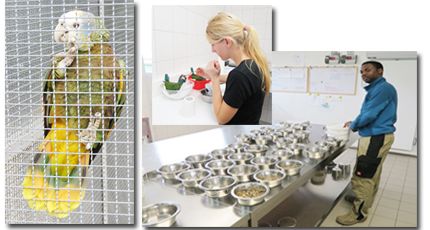Vincy parrots getting attention in Germany
 Friday, October 11, 2013 at 6:00
Friday, October 11, 2013 at 6:00  Left: A Vincy Parrot secured and well cared for at the ACTP facility in Germany. St.Lucian Timotheus Jean Baptiste, Project Coordinator, prepares food for the young parrots. Inset: Katrin Scholtyssek takes extra care in feeding a young parrot.Four Vincentian journalists will return to the state tomorrow following an assignment in Berlin, Germany.
Left: A Vincy Parrot secured and well cared for at the ACTP facility in Germany. St.Lucian Timotheus Jean Baptiste, Project Coordinator, prepares food for the young parrots. Inset: Katrin Scholtyssek takes extra care in feeding a young parrot.Four Vincentian journalists will return to the state tomorrow following an assignment in Berlin, Germany.
The Journalists, Duggie ‘Nose’ Joseph – The News newspaper, Audwin Andrews – Searchlight, Nadia Slater - Agency for Public Information(API) and Kenville Horne - THE VINCENTIAN newspaper, visited and observed firsthand operations at the state of the art parrot breeding facility in Berlin, where our own national bird, Amazona Guildingii, is housed.
The breeding facility is owned and operated by the Association for the Conservation of Threatened Parrots (ACTP)and is home to a wide variety of endangered parrots.
In 2006, the ACTP initiated a long term conservation programme for the national birds with the wildlife authorities in SVG. The programme includes measures to protect the remaining natural habitat of the species, which is crucial for the survival of parrots, and, the extension of the breeding centre and improving the management of the captive breeding population of the parrots at the aviary at the Botanical Gardens.
In 2011, 15 Vincy parrots were transferred to Germany as part of the conservation project. Additionally, 14 of the national birds were brought from the United States in 2012.
There are currently 15 pairs of the Amazona Guildingi at the ACTP breeding facility in Berlin.
Care for the young
Katrin Scholtyssek, bird keeper at the ACTO facility, led the delegation through the process of caring for the baby parrots.
At birth and through their infancy, the birds are kept in incubators.
During their early stages of life, they are fed a special food called F 19, their intake of this increasing as they get older. An artificial food referred to as mash, sunflower seeds and F-19 constitute their diet as the birds mature.
Regular checks on weight are made before and after every feeding.
Scholtyssek underscored the importance of having such a project continue in Germany, citing that if there was a large scale natural disaster in SVG, the population in the wild would be affected, and the facility therefore offers a chance to revive the stock.
Care for the adults
The adult parrots are housed in a total of 68 well kept aviaries and undergo weekly check-ups by Veterinarian, Dr. Mandy Carnarius.
Dr. Carnarius introduced the delegation to the different types of parrots at the facility, including the Spix’s Macaw, the world’s most endangered parrot, which is said to have last been sighted in the wild in October 2000. It originates in Brazil.
Dr. Carnarius stated that the Vincy parrots are very active and can be aggressive. She also noted that because of the cold climate in Germany, the parrots tend to grow more feathers than when they are in the tropics.
The delegation also visited the University of Berlin, where all of the birds arriving for eventual placement at the ACTP breeding facility have to be first quarantined.
Egyptian born Professor Hafez Mohamed Hafez, Vice President of the World Veterinary Poultry Association and head of the institute of Poultry Diseases at the Free University, gave an in depth explanation of what is undertaken by his Institute.
From all indications, the relationship between the Institute at the University and the ACTP is a close and unencumbered one.
The Vincentian delegation also met with President of ACTP, Martin Guth. He gave an overview of the project, and this was followed by a demonstration of the administering of Artificial Insemination for parrots.
The visit to Berlin, Germany was funded by the ACTP , while the SVG Ministry of Agricultural facilitated the process.

